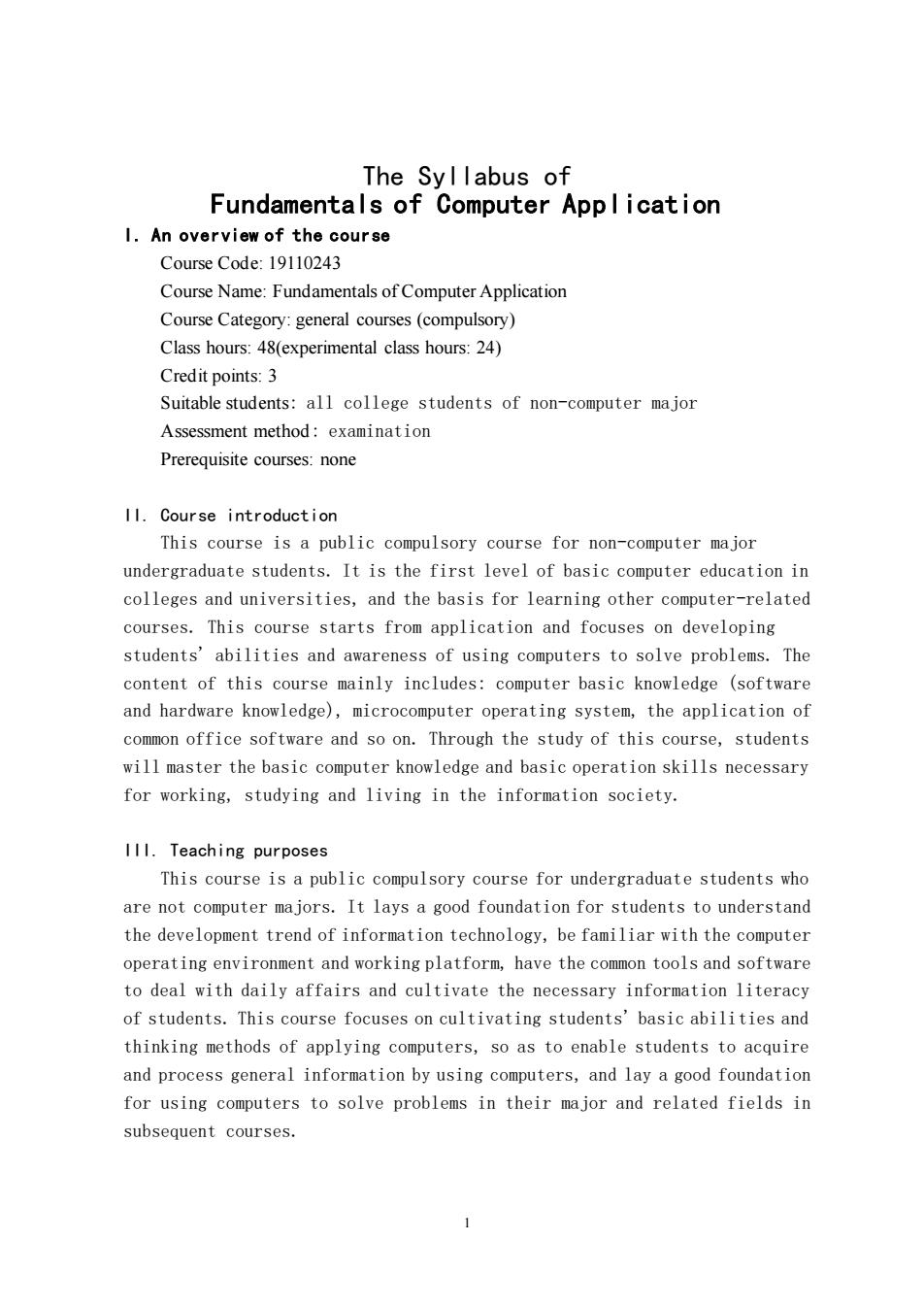
The Syllabus of Fundamentals of Computer Appl ication 1.An overview of the course Course Code:19110243 Course Name:Fundamentals of Computer Application Course Category:general courses (compulsory) Class hours:48(experimental class hours:24) Credit points:3 Suitable students:all college students of non-computer major Assessment method:examination Prerequisite courses:none I1.Course introduction This course is a public compulsory course for non-computer maior undergraduate students.It is the first level of basic computer education in colleges and universities,and the basis for learning other computer-related courses.This course starts from application and focuses on developing students'abilities and awareness of using computers to solve problems.The content of this course mainly includes:computer basic knowledge (software and hardware knowledge),microcomputer operating system,the application of common office software and so on.Through the study of this course,students will master the basic computer knowledge and basic operation skills necessary for working,studying and living in the information society. 111.Teaching purposes This course is a public compulsory course for undergraduate students who are not computer majors.It lays a good foundation for students to understand the development trend of information technology,be familiar with the computer operating environment and working platform,have the common tools and software to deal with daily affairs and cultivate the necessary information literacy of students.This course focuses on cultivating students'basic abilities and thinking methods of applying computers,so as to enable students to acquire and process general information by using computers,and lay a good foundation for using computers to solve problems in their major and related fields in subsequent courses
1 The Syllabus of Fundamentals of Computer Application I. An overview of the course Course Code: 19110243 Course Name: Fundamentals of Computer Application Course Category: general courses (compulsory) Class hours: 48(experimental class hours: 24) Credit points: 3 Suitable students: all college students of non-computer major Assessment method: examination Prerequisite courses: none II. Course introduction This course is a public compulsory course for non-computer major undergraduate students. It is the first level of basic computer education in colleges and universities, and the basis for learning other computer-related courses. This course starts from application and focuses on developing students' abilities and awareness of using computers to solve problems. The content of this course mainly includes: computer basic knowledge (software and hardware knowledge), microcomputer operating system, the application of common office software and so on. Through the study of this course, students will master the basic computer knowledge and basic operation skills necessary for working, studying and living in the information society. III. Teaching purposes This course is a public compulsory course for undergraduate students who are not computer majors. It lays a good foundation for students to understand the development trend of information technology, be familiar with the computer operating environment and working platform, have the common tools and software to deal with daily affairs and cultivate the necessary information literacy of students. This course focuses on cultivating students' basic abilities and thinking methods of applying computers, so as to enable students to acquire and process general information by using computers, and lay a good foundation for using computers to solve problems in their major and related fields in subsequent courses
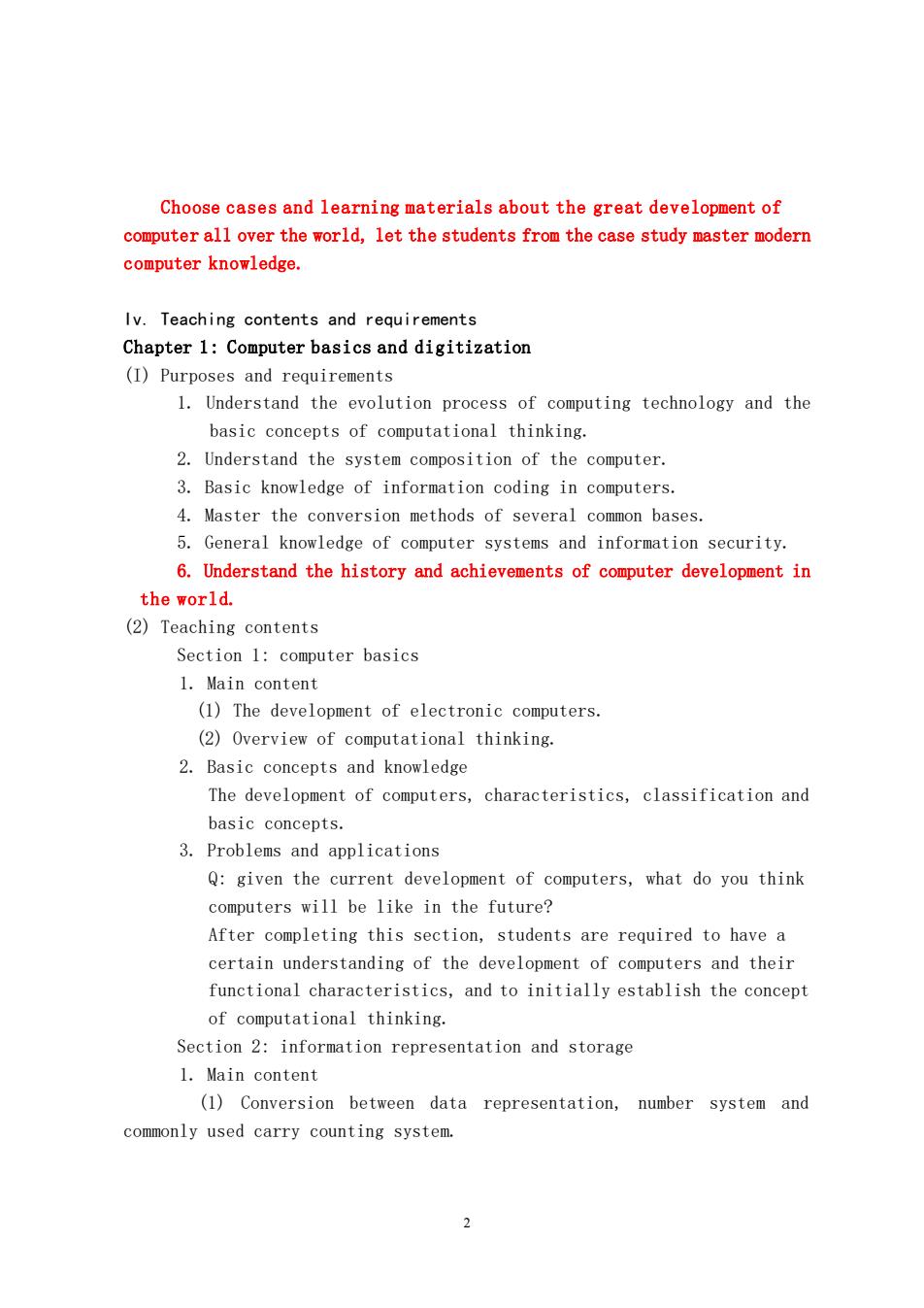
Choose cases and learning materials about the great development of computer all over the world,let the students from the case study master modern computer knowledge. Iv.Teaching contents and requirements Chapter 1:Computer basics and digitization (I)Purposes and requirements 1.Understand the evolution process of computing technology and the basic concepts of computational thinking. 2.Understand the system composition of the computer. 3.Basic knowledge of information coding in computers. 4.Master the conversion methods of several common bases 5.General knowledge of computer systems and information security. 6.Understand the history and achievements of computer development in the world. (2)Teaching contents Section 1:computer basics 1. Main content (1)The development of electronic computers. (2)Overview of computational thinking 2.Basic concepts and knowledge The development of computers,characteristics,classification and basic concepts. 3.Problems and applications Q:given the current development of computers,what do you think computers will be like in the future? After completing this section.students are required to have a certain understanding of the development of computers and their functional characteristics,and to initially establish the concept of computational thinking. Section 2:information representation and storage 1.Main content (1)Conversion between data representation,number system and commonly used carry counting system. 2
2 Choose cases and learning materials about the great development of computer all over the world, let the students from the case study master modern computer knowledge. Iv. Teaching contents and requirements Chapter 1: Computer basics and digitization (I) Purposes and requirements 1. Understand the evolution process of computing technology and the basic concepts of computational thinking. 2. Understand the system composition of the computer. 3. Basic knowledge of information coding in computers. 4. Master the conversion methods of several common bases. 5. General knowledge of computer systems and information security. 6. Understand the history and achievements of computer development in the world. (2) Teaching contents Section 1: computer basics 1. Main content (1) The development of electronic computers. (2) Overview of computational thinking. 2. Basic concepts and knowledge The development of computers, characteristics, classification and basic concepts. 3. Problems and applications Q: given the current development of computers, what do you think computers will be like in the future? After completing this section, students are required to have a certain understanding of the development of computers and their functional characteristics, and to initially establish the concept of computational thinking. Section 2: information representation and storage 1. Main content (1) Conversion between data representation, number system and commonly used carry counting system
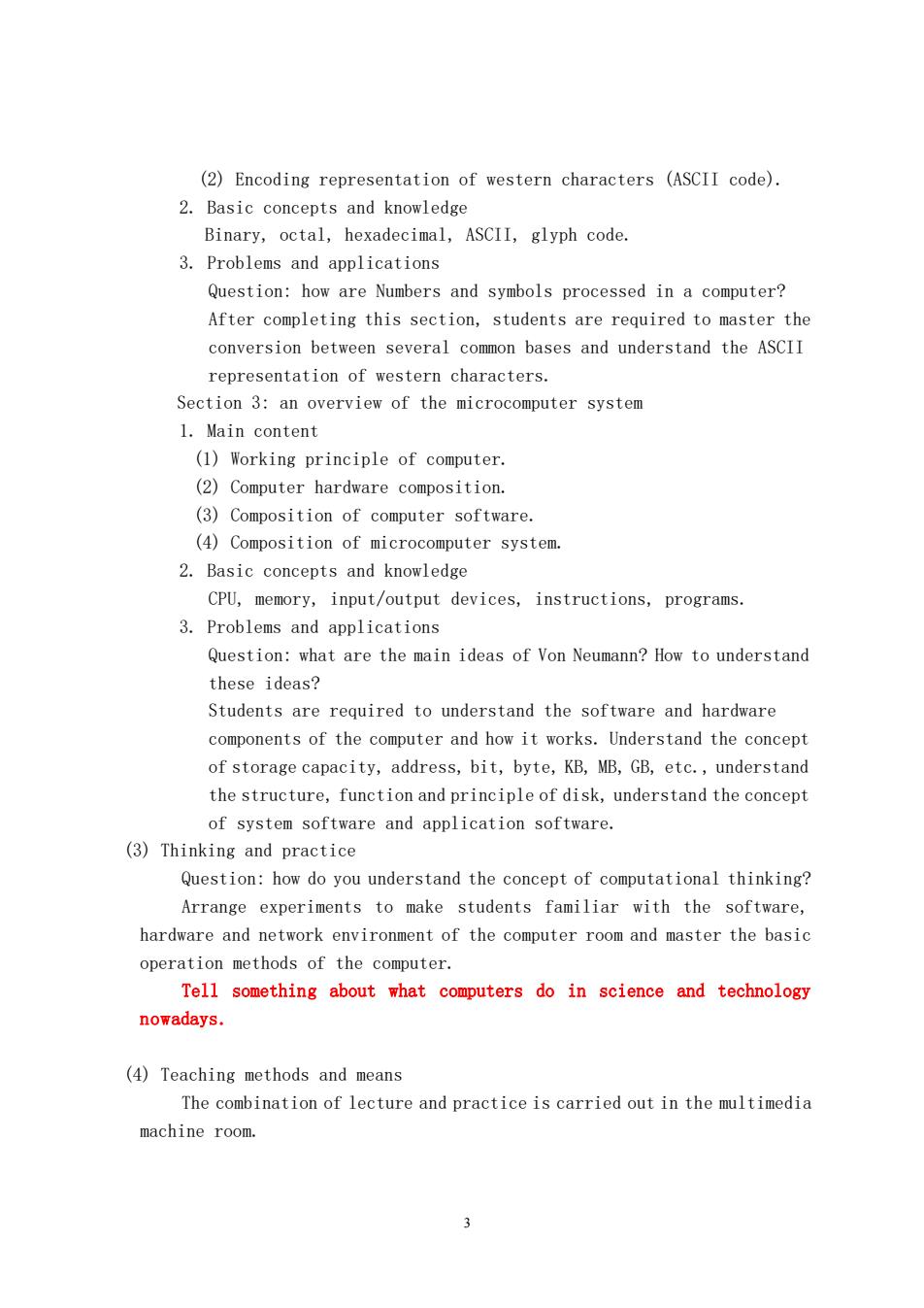
(2)Encoding representation of western characters (ASCII code). 2.Basic concepts and knowledge Binary,octal,hexadecimal,ASCII,glyph code. 3.Problems and applications Question:how are Numbers and symbols processed in a computer? After completing this section,students are required to master the conversion between several common bases and understand the ASCII representation of western characters. Section 3:an overview of the microcomputer system 1.Main content (1)Working principle of computer (2)Computer hardware composition. (3)Composition of computer software (4)Composition of microcomputer system. 2.Basic concepts and knowledge CPU,memory,input/output devices,instructions,programs. 3.Problems and applications Question:what are the main ideas of Von Neumann?How to understand these ideas? Students are required to understand the software and hardware components of the computer and how it works.Understand the concept of storage capacity.address.bit.byte.KB.MB.GB.etc..understand the structure,function and principle of disk,understand the concept of system software and application software. (3)Thinking and practice Question:how do you understand the concept of computational thinking? Arrange experiments to make students familiar with the software, hardware and network environment of the computer room and master the basic operation methods of the computer. Tell something about what computers do in science and technology nowadays. (4)Teaching methods and means The combination of lecture and practice is carried out in the multimedia machine room. 3
3 (2) Encoding representation of western characters (ASCII code). 2. Basic concepts and knowledge Binary, octal, hexadecimal, ASCII, glyph code. 3. Problems and applications Question: how are Numbers and symbols processed in a computer? After completing this section, students are required to master the conversion between several common bases and understand the ASCII representation of western characters. Section 3: an overview of the microcomputer system 1. Main content (1) Working principle of computer. (2) Computer hardware composition. (3) Composition of computer software. (4) Composition of microcomputer system. 2. Basic concepts and knowledge CPU, memory, input/output devices, instructions, programs. 3. Problems and applications Question: what are the main ideas of Von Neumann? How to understand these ideas? Students are required to understand the software and hardware components of the computer and how it works. Understand the concept of storage capacity, address, bit, byte, KB, MB, GB, etc., understand the structure, function and principle of disk, understand the concept of system software and application software. (3) Thinking and practice Question: how do you understand the concept of computational thinking? Arrange experiments to make students familiar with the software, hardware and network environment of the computer room and master the basic operation methods of the computer. Tell something about what computers do in science and technology nowadays. (4) Teaching methods and means The combination of lecture and practice is carried out in the multimedia machine room
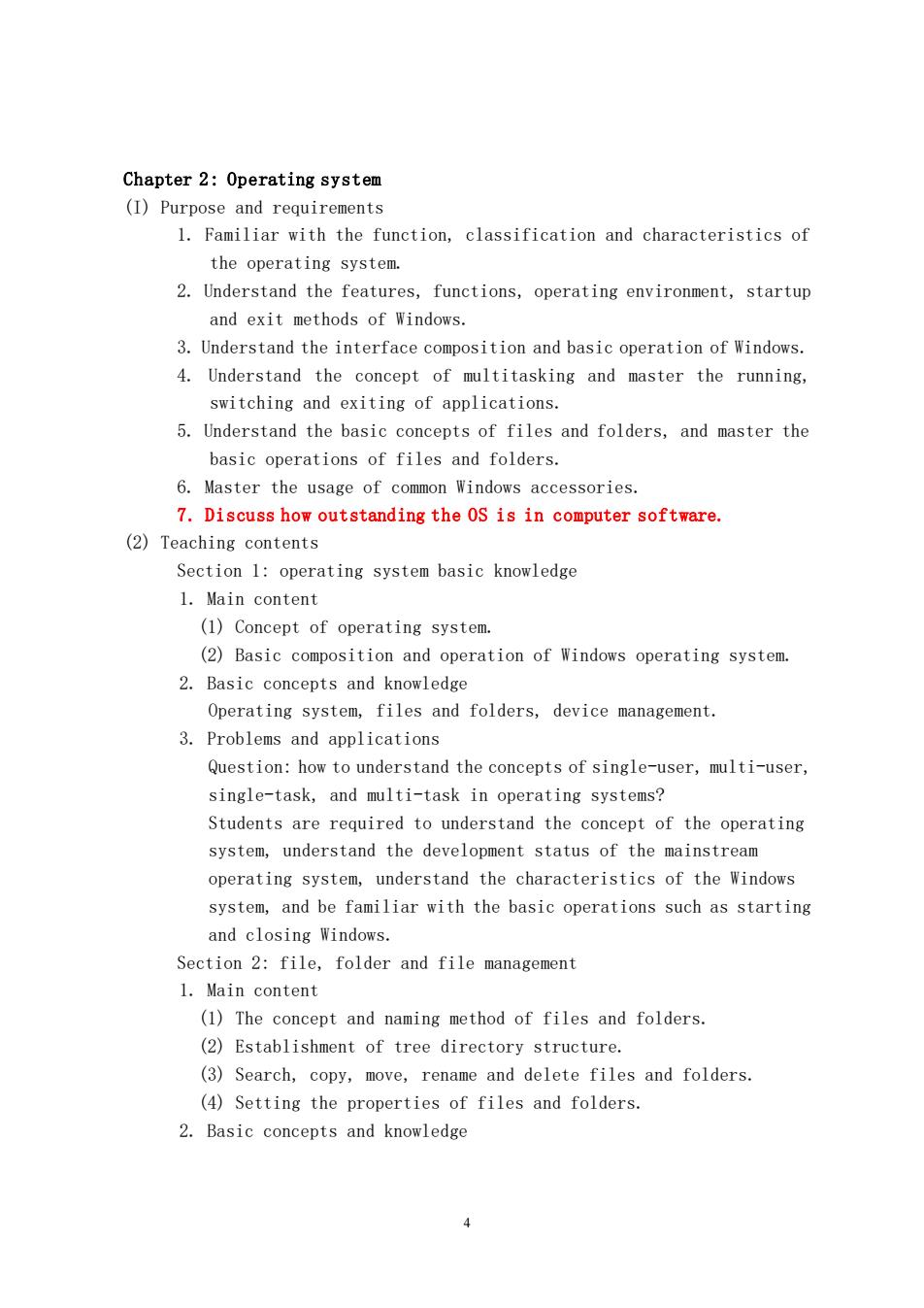
Chapter 2:Operating system (I)Purpose and requirements 1.Familiar with the function,classification and characteristics of the operating system. 2.Understand the features,functions,operating environment,startup and exit methods of Windows. 3.Understand the interface composition and basic operation of Windows. 4.Understand the concept of multitasking and master the running, switching and exiting of applications. 5.Understand the basic concepts of files and folders,and master the basic operations of files and folders. 6.Master the usage of common Windows accessories. 7.Discuss how outstanding the oS is in computer software. (2)Teaching contents Section 1:operating system basic knowledge 1.Main content (1)Concept of operating system. (2)Basic composition and operation of Windows operating system. 2.Basic concepts and knowledge Operating system,files and folders,device management. 3.Problems and applications Question:how to understand the concepts of single-user,multi-user, single-task,and multi-task in operating systems? Students are required to understand the concept of the operating system,understand the development status of the mainstream operating system,understand the characteristics of the Windows system,and be familiar with the basic operations such as starting and closing windows. Section 2:file,folder and file management 1.Main content (1)The concept and naming method of files and folders. (2)Establishment of tree directory structure. (3)Search,copy,move,rename and delete files and folders. (4)Setting the properties of files and folders. 2.Basic concepts and knowledge 4
4 Chapter 2: Operating system (I) Purpose and requirements 1. Familiar with the function, classification and characteristics of the operating system. 2. Understand the features, functions, operating environment, startup and exit methods of Windows. 3. Understand the interface composition and basic operation of Windows. 4. Understand the concept of multitasking and master the running, switching and exiting of applications. 5. Understand the basic concepts of files and folders, and master the basic operations of files and folders. 6. Master the usage of common Windows accessories. 7. Discuss how outstanding the OS is in computer software. (2) Teaching contents Section 1: operating system basic knowledge 1. Main content (1) Concept of operating system. (2) Basic composition and operation of Windows operating system. 2. Basic concepts and knowledge Operating system, files and folders, device management. 3. Problems and applications Question: how to understand the concepts of single-user, multi-user, single-task, and multi-task in operating systems? Students are required to understand the concept of the operating system, understand the development status of the mainstream operating system, understand the characteristics of the Windows system, and be familiar with the basic operations such as starting and closing Windows. Section 2: file, folder and file management 1. Main content (1) The concept and naming method of files and folders. (2) Establishment of tree directory structure. (3) Search, copy, move, rename and delete files and folders. (4) Setting the properties of files and folders. 2. Basic concepts and knowledge
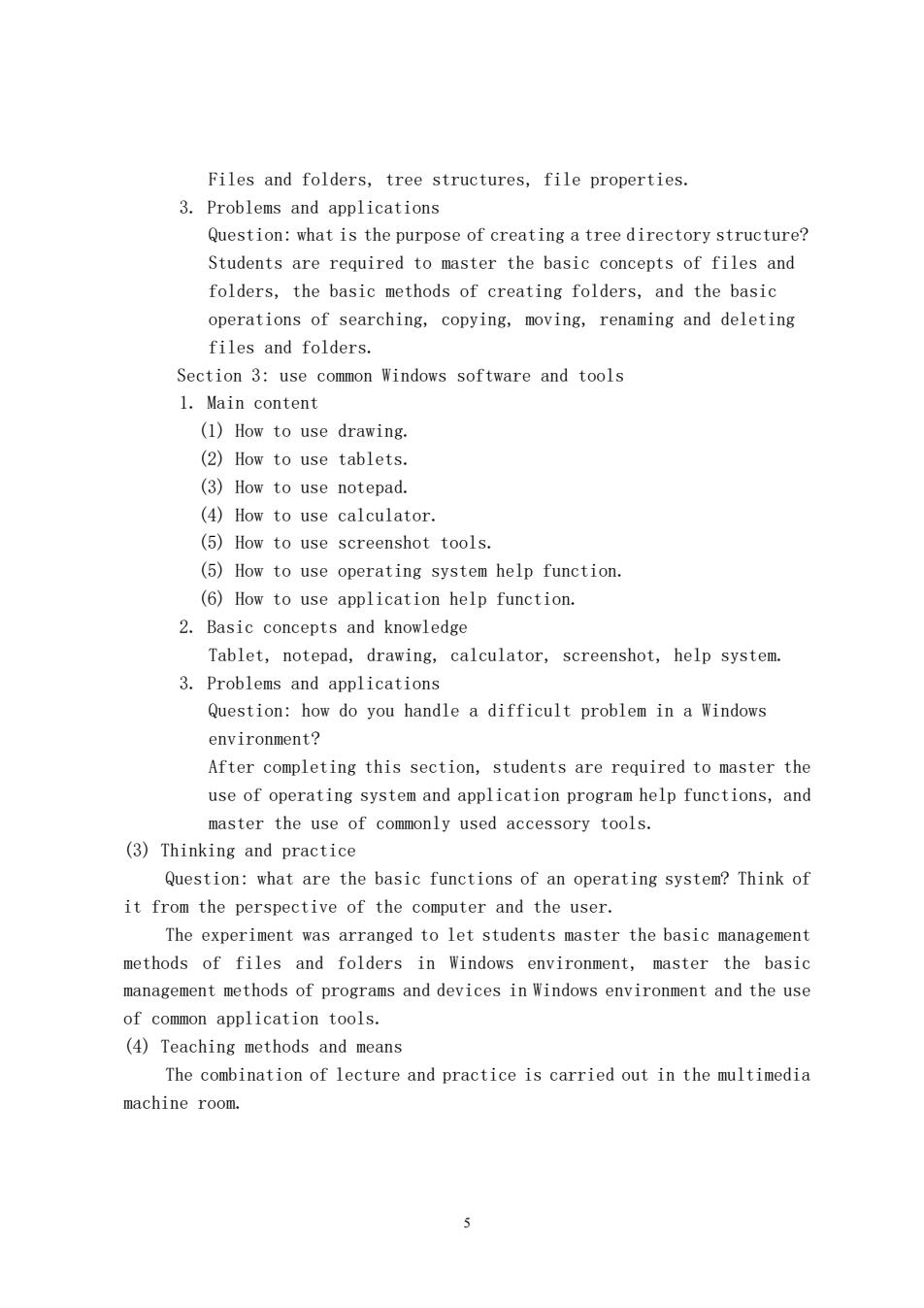
Files and folders,tree structures,file properties. 3.Problems and applications Question:what is the purpose of creating a tree directory structure? Students are required to master the basic concepts of files and folders.the basic methods of creating folders.and the basic operations of searching,copying,moving,renaming and deleting files and folders. Section 3:use common Windows software and tools 1.Main content (1)How to use drawing. (2)How to use tablets. (3)How to use notepad. (4)How to use calculator (5)How to use screenshot tools. (5)How to use operating system help function (6)How to use application help function. 2.Basic concepts and knowledge Tablet,notepad,drawing,calculator,screenshot,help system. 3.Problems and applications Question:how do you handle a difficult problem in a Windows environment? After completing this section.students are required to master the use of operating system and application program help functions,and master the use of commonly used accessory tools. (3)Thinking and practice Question:what are the basic functions of an operating system?Think of it from the perspective of the computer and the user. The experiment was arranged to let students master the basic management methods of files and folders in Windows environment,master the basic management methods of programs and devices in Windows environment and the use of common application tools. (4)Teaching methods and means The combination of lecture and practice is carried out in the multimedia machine room. 5
5 Files and folders, tree structures, file properties. 3. Problems and applications Question: what is the purpose of creating a tree directory structure? Students are required to master the basic concepts of files and folders, the basic methods of creating folders, and the basic operations of searching, copying, moving, renaming and deleting files and folders. Section 3: use common Windows software and tools 1. Main content (1) How to use drawing. (2) How to use tablets. (3) How to use notepad. (4) How to use calculator. (5) How to use screenshot tools. (5) How to use operating system help function. (6) How to use application help function. 2. Basic concepts and knowledge Tablet, notepad, drawing, calculator, screenshot, help system. 3. Problems and applications Question: how do you handle a difficult problem in a Windows environment? After completing this section, students are required to master the use of operating system and application program help functions, and master the use of commonly used accessory tools. (3) Thinking and practice Question: what are the basic functions of an operating system? Think of it from the perspective of the computer and the user. The experiment was arranged to let students master the basic management methods of files and folders in Windows environment, master the basic management methods of programs and devices in Windows environment and the use of common application tools. (4) Teaching methods and means The combination of lecture and practice is carried out in the multimedia machine room
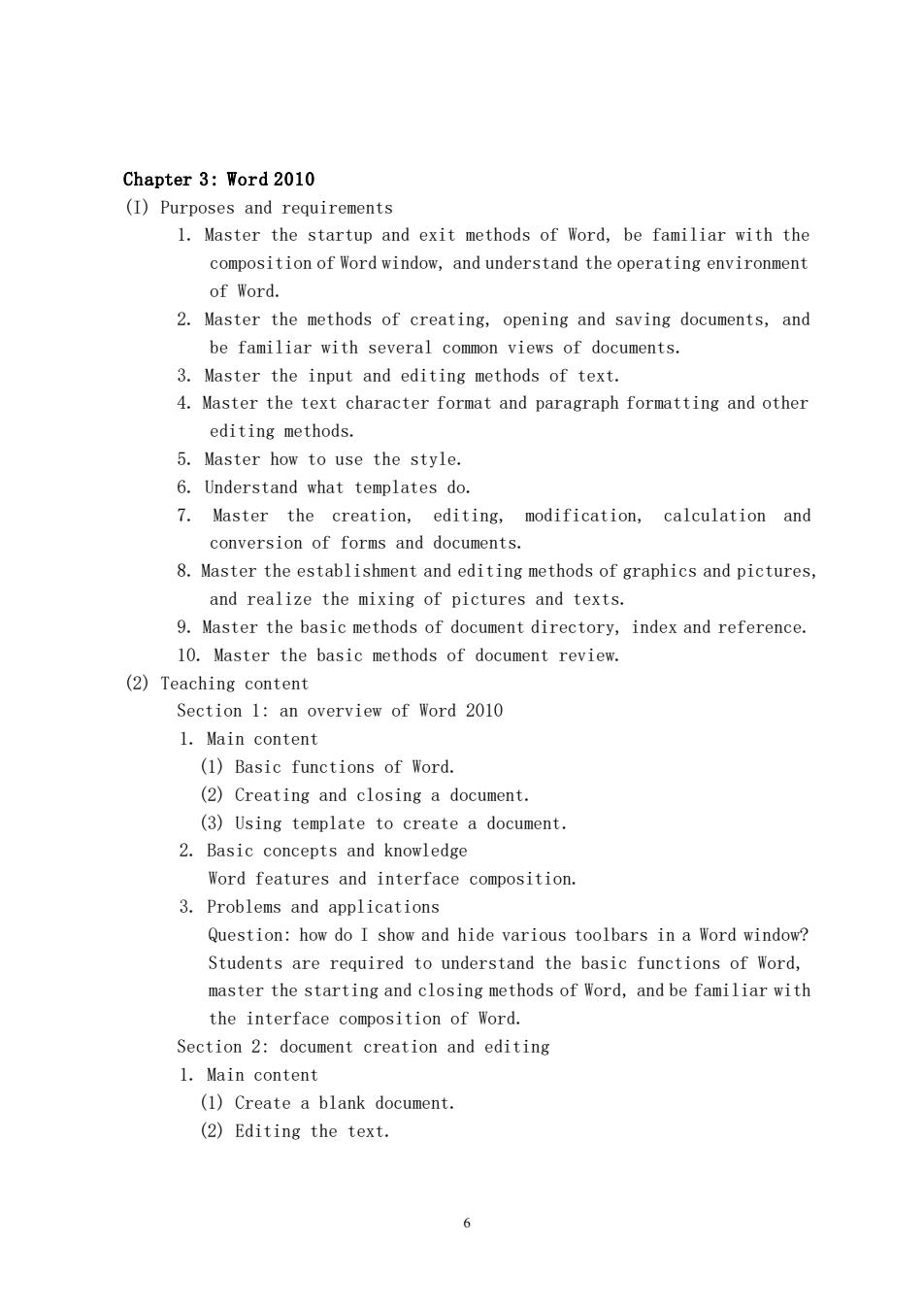
Chapter 3:Word 2010 (I)Purposes and requirements 1.Master the startup and exit methods of Word,be familiar with the composition of Word window,and understand the operating environment of Word. 2.Master the methods of creating,opening and saving documents,and be familiar with several common views of documents. 3.Master the input and editing methods of text. 4.Master the text character format and paragraph formatting and other editing methods. 5.Master how to use the style 6.Understand what templates do. 7.Master the creation,editing, modification,calculation and conversion of forms and documents. 8.Master the establishment and editing methods of graphics and pictures, and realize the mixing of pictures and texts. 9.Master the basic methods of document directory,index and reference 10.Master the basic methods of document review. (2)Teaching content Section 1:an overview of Word 2010 1.Main content (1)Basic functions of Word. (2)Creating and closing a document. (3)Using template to create a document. 2.Basic concepts and knowledge Word features and interface composition. 3.Problems and applications Question:how do I show and hide various toolbars in a Word window? Students are required to understand the basic functions of Word, master the starting and closing methods of Word,and be familiar with the interface composition of Word. Section 2:document creation and editing 1.Main content (1)Create a blank document. (2)Editing the text. 6
6 Chapter 3: Word 2010 (I) Purposes and requirements 1. Master the startup and exit methods of Word, be familiar with the composition of Word window, and understand the operating environment of Word. 2. Master the methods of creating, opening and saving documents, and be familiar with several common views of documents. 3. Master the input and editing methods of text. 4. Master the text character format and paragraph formatting and other editing methods. 5. Master how to use the style. 6. Understand what templates do. 7. Master the creation, editing, modification, calculation and conversion of forms and documents. 8. Master the establishment and editing methods of graphics and pictures, and realize the mixing of pictures and texts. 9. Master the basic methods of document directory, index and reference. 10. Master the basic methods of document review. (2) Teaching content Section 1: an overview of Word 2010 1. Main content (1) Basic functions of Word. (2) Creating and closing a document. (3) Using template to create a document. 2. Basic concepts and knowledge Word features and interface composition. 3. Problems and applications Question: how do I show and hide various toolbars in a Word window? Students are required to understand the basic functions of Word, master the starting and closing methods of Word, and be familiar with the interface composition of Word. Section 2: document creation and editing 1. Main content (1) Create a blank document. (2) Editing the text
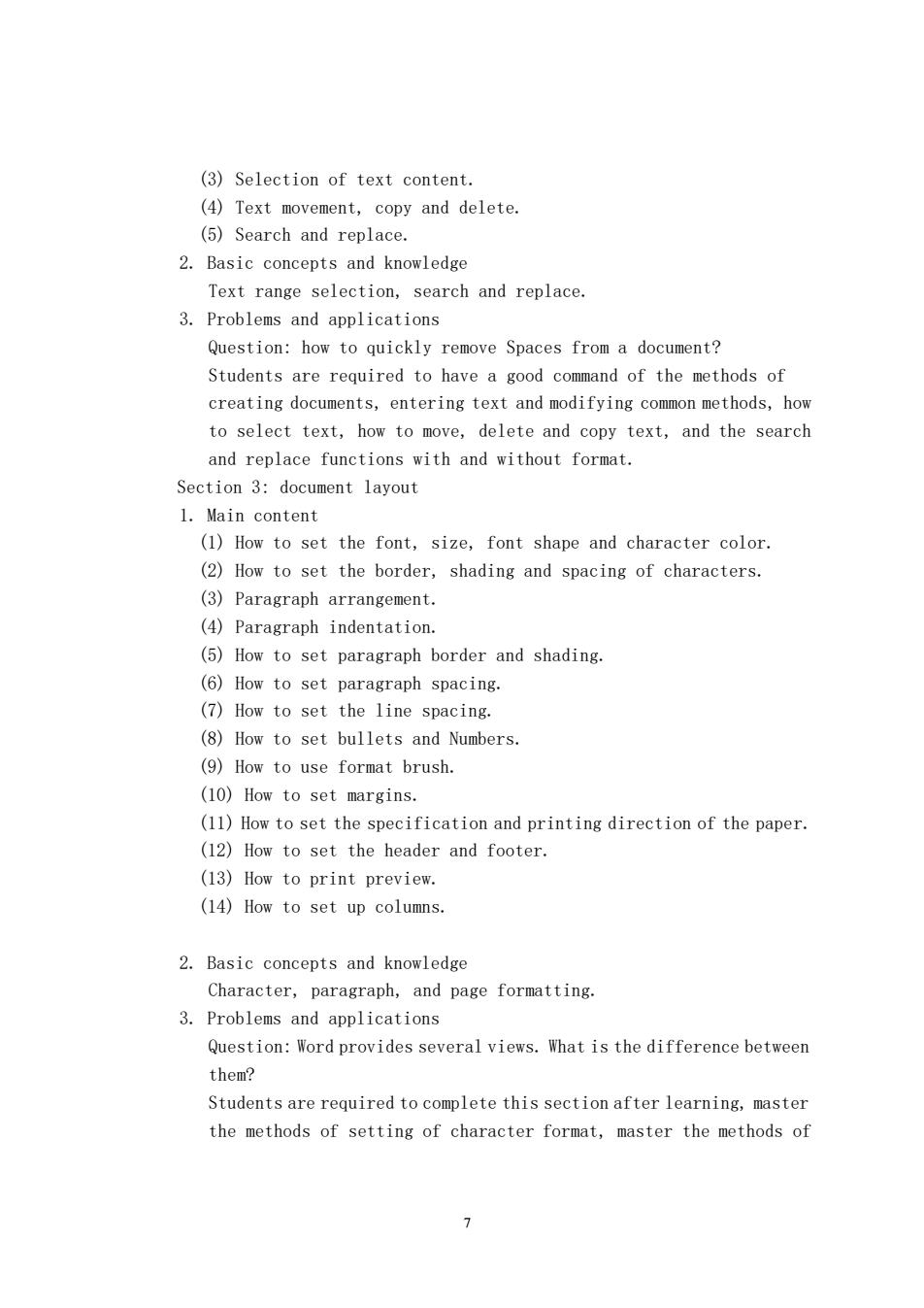
(3)Selection of text content. (4)Text movement,copy and delete. (5)Search and replace. 2.Basic concepts and knowledge Text range selection,search and replace. 3.Problems and applications Question:how to quickly remove Spaces from a document? Students are required to have a good command of the methods of creating documents,entering text and modifying common methods,how to select text,how to move,delete and copy text,and the search and replace functions with and without format. Section 3:document layout 1.Main content (1)How to set the font,size,font shape and character color. (2)How to set the border,shading and spacing of characters. (3)Paragraph arrangement. (4)Paragraph indentation (5)How to set paragraph border and shading. (6)How to set paragraph spacing. (7)How to set the line spacing. (8)How to set bullets and Numbers. (9)How to use format brush. (10)How to set margins. (11)How to set the specification and printing direction of the paper. (12)How to set the header and footer. (13)How to print preview. (14)How to set up columns. 2.Basic concepts and knowledge Character,paragraph,and page formatting. 3.Problems and applications Question:Word provides several views.What is the difference between them? Students are required to complete this section after learning,master the methods of setting of character format,master the methods of
7 (3) Selection of text content. (4) Text movement, copy and delete. (5) Search and replace. 2. Basic concepts and knowledge Text range selection, search and replace. 3. Problems and applications Question: how to quickly remove Spaces from a document? Students are required to have a good command of the methods of creating documents, entering text and modifying common methods, how to select text, how to move, delete and copy text, and the search and replace functions with and without format. Section 3: document layout 1. Main content (1) How to set the font, size, font shape and character color. (2) How to set the border, shading and spacing of characters. (3) Paragraph arrangement. (4) Paragraph indentation. (5) How to set paragraph border and shading. (6) How to set paragraph spacing. (7) How to set the line spacing. (8) How to set bullets and Numbers. (9) How to use format brush. (10) How to set margins. (11) How to set the specification and printing direction of the paper. (12) How to set the header and footer. (13) How to print preview. (14) How to set up columns. 2. Basic concepts and knowledge Character, paragraph, and page formatting. 3. Problems and applications Question: Word provides several views. What is the difference between them? Students are required to complete this section after learning, master the methods of setting of character format, master the methods of
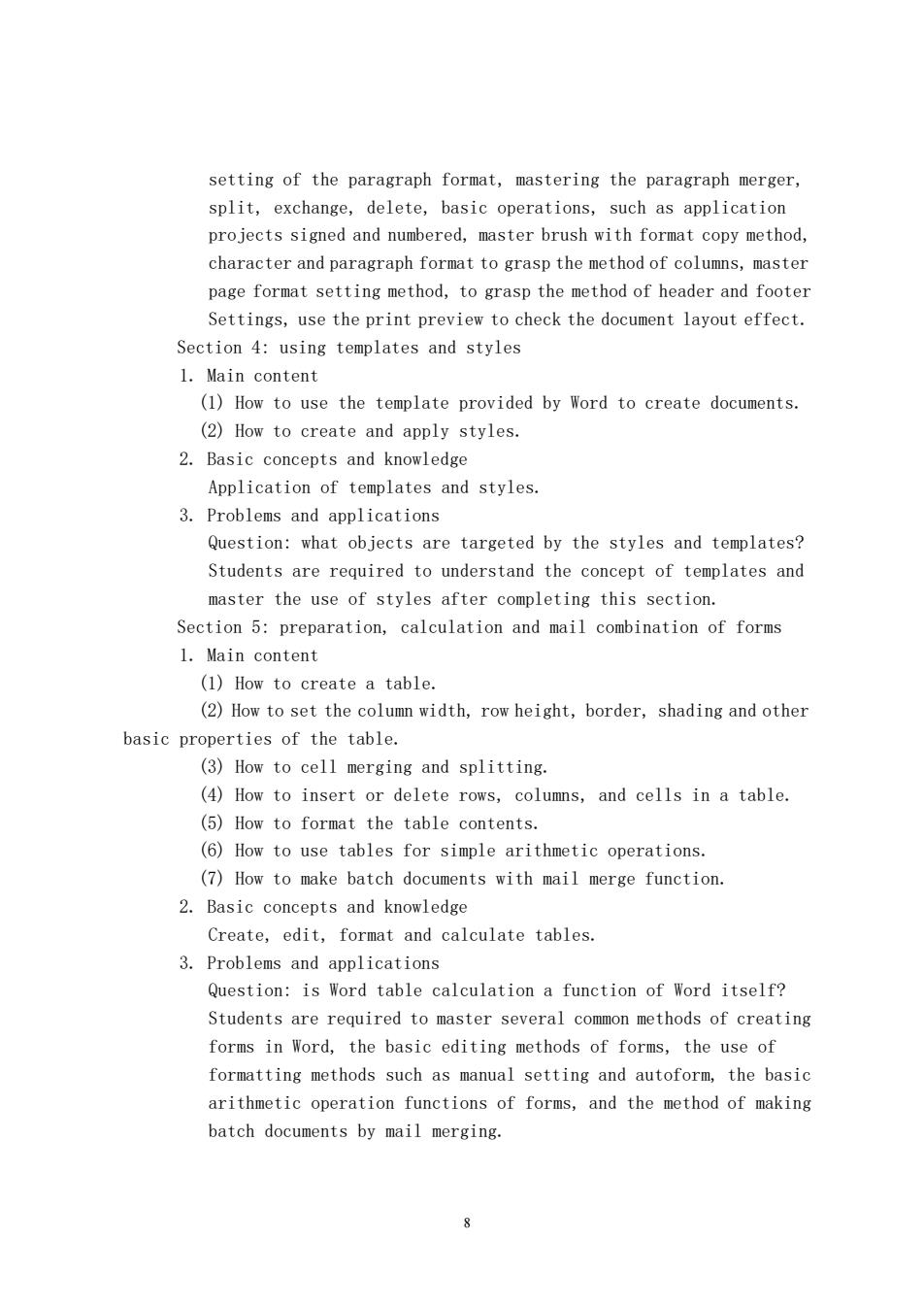
setting of the paragraph format,mastering the paragraph merger, split,exchange,delete,basic operations,such as application projects signed and numbered,master brush with format copy method, character and paragraph format to grasp the method of columns,master page format setting method,to grasp the method of header and footer Settings,use the print preview to check the document layout effect. Section 4:using templates and styles 1.Main content (1 How to use the template provided by Word to create documents. (2)How to create and apply styles. 2.Basic concepts and knowledge Application of templates and styles. 3.Problems and applications Question:what objects are targeted by the styles and templates? Students are required to understand the concept of templates and master the use of styles after completing this section. Section 5:preparation,calculation and mail combination of forms 1.Main content (1)How to create a table (2)How to set the column width,row height,border,shading and other basic properties of the table. (3)How to cell merging and splitting. (4)How to insert or delete rows,columns,and cells in a table (5)How to format the table contents. (6)How to use tables for simple arithmetic operations. (7)How to make batch documents with mail merge function. 2.Basic concepts and knowledge Create.edit.format and calculate tables. 3.Problems and applications Question:is Word table calculation a function of Word itself? Students are required to master several common methods of creating forms in Word,the basic editing methods of forms,the use of formatting methods such as manual setting and autoform,the basic arithmetic operation functions of forms,and the method of making batch documents by mail merging. 8
8 setting of the paragraph format, mastering the paragraph merger, split, exchange, delete, basic operations, such as application projects signed and numbered, master brush with format copy method, character and paragraph format to grasp the method of columns, master page format setting method, to grasp the method of header and footer Settings, use the print preview to check the document layout effect. Section 4: using templates and styles 1. Main content (1) How to use the template provided by Word to create documents. (2) How to create and apply styles. 2. Basic concepts and knowledge Application of templates and styles. 3. Problems and applications Question: what objects are targeted by the styles and templates? Students are required to understand the concept of templates and master the use of styles after completing this section. Section 5: preparation, calculation and mail combination of forms 1. Main content (1) How to create a table. (2) How to set the column width, row height, border, shading and other basic properties of the table. (3) How to cell merging and splitting. (4) How to insert or delete rows, columns, and cells in a table. (5) How to format the table contents. (6) How to use tables for simple arithmetic operations. (7) How to make batch documents with mail merge function. 2. Basic concepts and knowledge Create, edit, format and calculate tables. 3. Problems and applications Question: is Word table calculation a function of Word itself? Students are required to master several common methods of creating forms in Word, the basic editing methods of forms, the use of formatting methods such as manual setting and autoform, the basic arithmetic operation functions of forms, and the method of making batch documents by mail merging
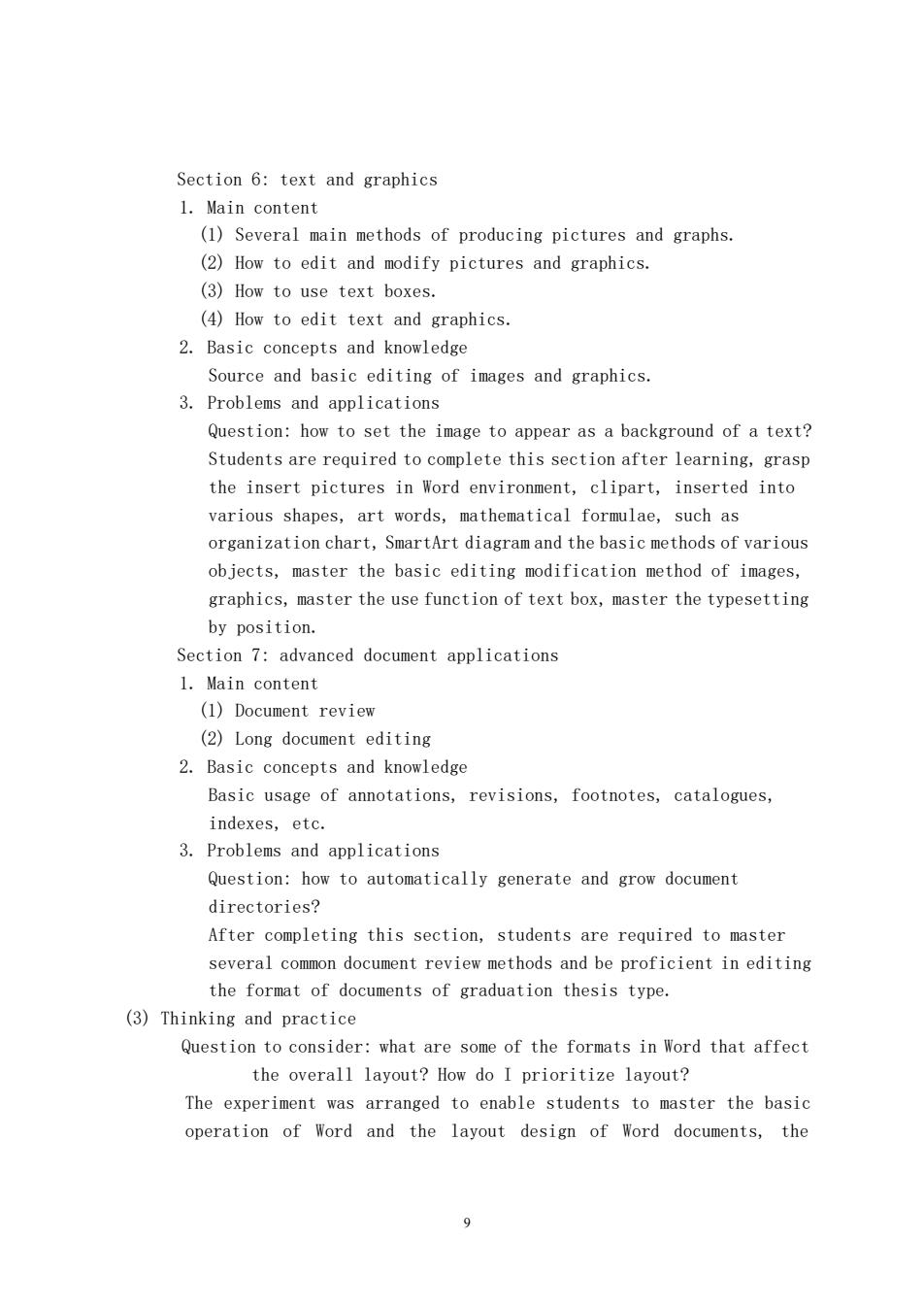
Section 6:text and graphics 1.Main content (1)Several main methods of producing pictures and graphs. (2)How to edit and modify pictures and graphics. (3)How to use text boxes. (4)How to edit text and graphics. 2.Basic concepts and knowledge Source and basic editing of images and graphics. 3.Problems and applications Question:how to set the image to appear as a background of a text? Students are required to complete this section after learning.grasp the insert pictures in Word environment,clipart,inserted into various shapes,art words,mathematical formulae,such as organization chart,SmartArt diagram and the basic methods of various objects,master the basic editing modification method of images graphics,master the use function of text box,master the typesetting by position, Section 7:advanced document applications 1.Main content (1)Document review (2)Long document editing 2.Basic concepts and knowledge Basic usage of annotations,revisions,footnotes,catalogues, indexes.etc. 3.Problems and applications Question:how to automatically generate and grow document directories? After completing this section,students are required to master several common document review methods and be proficient in editing the format of documents of graduation thesis type. (3)Thinking and practice Question to consider:what are some of the formats in Word that affect the overall layout?How do I prioritize layout? The experiment was arranged to enable students to master the basic operation of Word and the layout design of Word documents,the
9 Section 6: text and graphics 1. Main content (1) Several main methods of producing pictures and graphs. (2) How to edit and modify pictures and graphics. (3) How to use text boxes. (4) How to edit text and graphics. 2. Basic concepts and knowledge Source and basic editing of images and graphics. 3. Problems and applications Question: how to set the image to appear as a background of a text? Students are required to complete this section after learning, grasp the insert pictures in Word environment, clipart, inserted into various shapes, art words, mathematical formulae, such as organization chart, SmartArt diagram and the basic methods of various objects, master the basic editing modification method of images, graphics, master the use function of text box, master the typesetting by position. Section 7: advanced document applications 1. Main content (1) Document review (2) Long document editing 2. Basic concepts and knowledge Basic usage of annotations, revisions, footnotes, catalogues, indexes, etc. 3. Problems and applications Question: how to automatically generate and grow document directories? After completing this section, students are required to master several common document review methods and be proficient in editing the format of documents of graduation thesis type. (3) Thinking and practice Question to consider: what are some of the formats in Word that affect the overall layout? How do I prioritize layout? The experiment was arranged to enable students to master the basic operation of Word and the layout design of Word documents, the
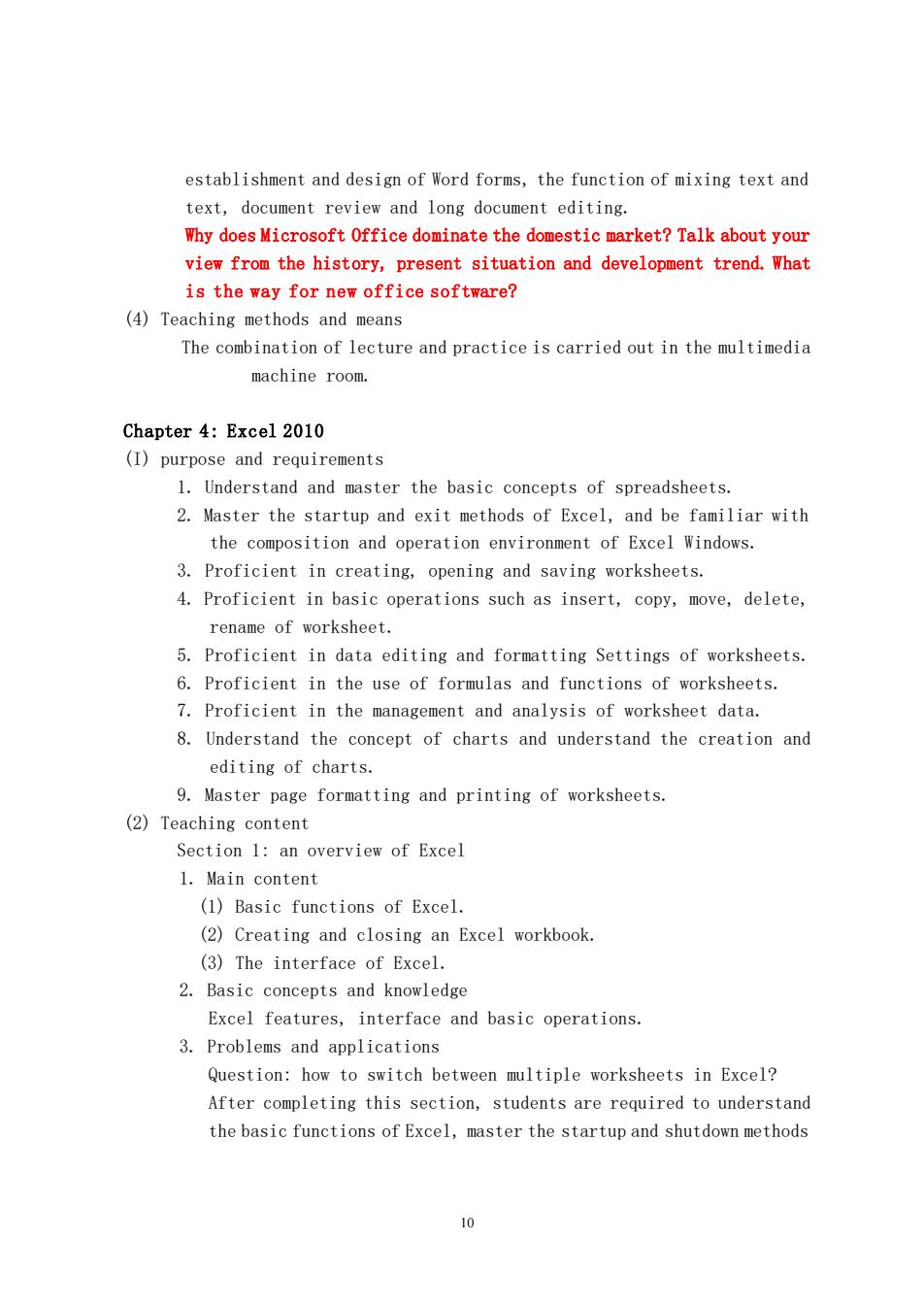
establishment and design of Word forms,the function of mixing text and text,document review and long document editing. Why does Microsoft Office dominate the domestic market?Talk about your view from the history,present situation and development trend.What is the way for new office software? (4)Teaching methods and means The combination of lecture and practice is carried out in the multimedia machine room. Chapter 4:Excel 2010 (I)purpose and requirements 1.Understand and master the basic concepts of spreadsheets. 2.Master the startup and exit methods of Excel,and be familiar with the composition and operation environment of Excel Windows. 3.Proficient in creating,opening and saving worksheets. 4.Proficient in basic operations such as insert,copy,move,delete, rename of worksheet. 5.Proficient in data editing and formatting Settings of worksheets. 6.Proficient in the use of formulas and functions of worksheets. 7.Proficient in the management and analysis of worksheet data. 8.Understand the concept of charts and understand the creation and editing of charts. 9.Master page formatting and printing of worksheets. (2)Teaching content Section 1:an overview of Excel 1.Main content (1)Basic functions of Excel (2)Creating and closing an Excel workbook. (3)The interface of Excel 2.Basic concepts and knowledge Excel features,interface and basic operations. 3.Problems and applications Question:how to switch between multiple worksheets in Excel? After completing this section,students are required to understand the basic functions of Excel,master the startup and shutdown methods 10
10 establishment and design of Word forms, the function of mixing text and text, document review and long document editing. Why does Microsoft Office dominate the domestic market? Talk about your view from the history, present situation and development trend. What is the way for new office software? (4) Teaching methods and means The combination of lecture and practice is carried out in the multimedia machine room. Chapter 4: Excel 2010 (I) purpose and requirements 1. Understand and master the basic concepts of spreadsheets. 2. Master the startup and exit methods of Excel, and be familiar with the composition and operation environment of Excel Windows. 3. Proficient in creating, opening and saving worksheets. 4. Proficient in basic operations such as insert, copy, move, delete, rename of worksheet. 5. Proficient in data editing and formatting Settings of worksheets. 6. Proficient in the use of formulas and functions of worksheets. 7. Proficient in the management and analysis of worksheet data. 8. Understand the concept of charts and understand the creation and editing of charts. 9. Master page formatting and printing of worksheets. (2) Teaching content Section 1: an overview of Excel 1. Main content (1) Basic functions of Excel. (2) Creating and closing an Excel workbook. (3) The interface of Excel. 2. Basic concepts and knowledge Excel features, interface and basic operations. 3. Problems and applications Question: how to switch between multiple worksheets in Excel? After completing this section, students are required to understand the basic functions of Excel, master the startup and shutdown methods